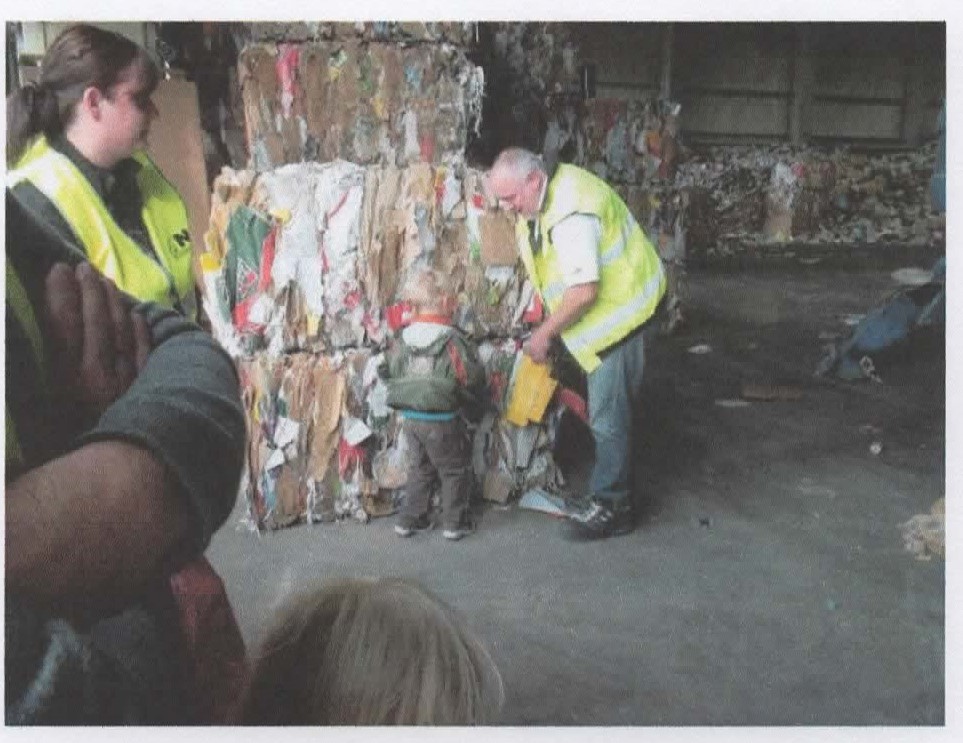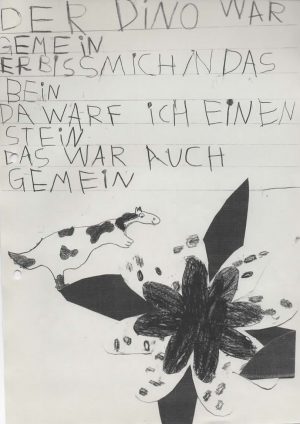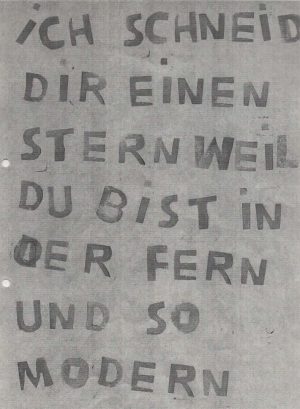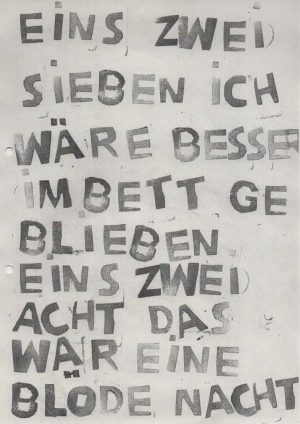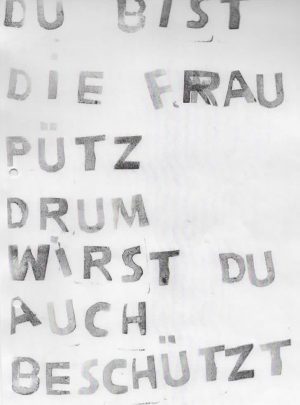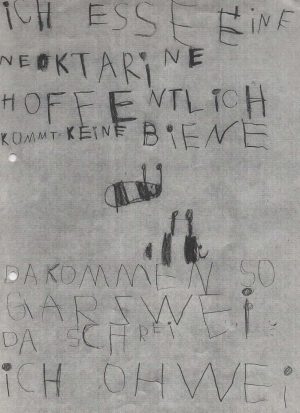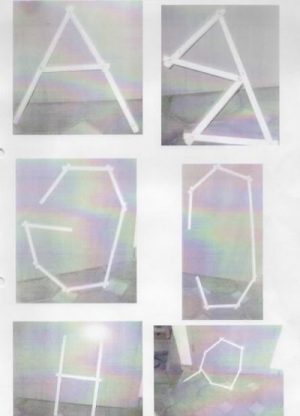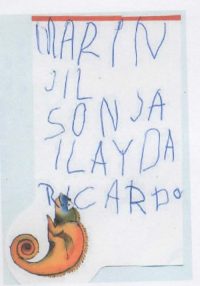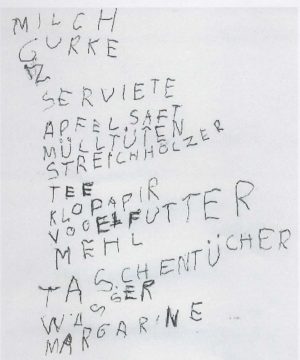by Hanna Vock
1.
Learning is a basic human need.
Man is a learning and researching being. He begins to be so as soon as his brain (in the womb) is developed enough to do so, and he remains so as long as his brain functions sufficiently well to absorb and process new information, i.e. until death or severe dementia.
…in a nutshell…
While there is much talk throughout this Manual about the learning of gifted children, this article attempts to look at learning in general.
The outline is:
1. Learning is a basic human need.
2. What happens in the brain when we learn?
3. What do people learn in their lives?
4. Are feelings also learned?
5. What role do concepts play?
6. Exploratory learning and scientific research – similarities and differences.
Every child comes into the world with predispositions for thinking and research. These dispositions are highly complex, plastic and dynamic. They develop – with the possibility of atrophy or damage always included.
We humans are intrinsically motivated to develop cognitively. There is a basic need for new impressions (sensory impressions, information).
And there is another basic need: for central processing of this information (understanding, storing).
These two basic needs are similarly important as our other basic needs – for food, warmth, affection, movement, etc.
Just like them, these basic cognitive needs vary in strength from individual to individual: they are generally stronger in children than in most adults; they are more intensely expressed in gifted children than in non-gifted children.
And since gifted children absorb and process a lot of information early on, i.e. practice thinking and learning at an early age, they achieve astonishing thinking skills at an early age. Here too – in addition to genetic predispositions – practice makes perfect! As with virtuoso athletes or artists or programmers, the impression then easily comes about that „it comes as if by itself“ and the children themselves are not surprised either; at most, they are surprised at an early age that adults are amazed at the ease with which they solve certain tasks.
An example:
Piaget describes an experimental set-up whose mental solution he did not observe in young children.
I recreated the situation and was able to see that little Pete (4;0) had no cognitive problem at all in assessing the situation (that is, he saw it just as clearly and instantly as many adults):
A doll sits at one side of the table, a teddy at another, and the remaining two sides of the table are occupied by me and Pete. With an opaque cloth held over the table in various ways, different situations arise.
First, the cloth was held so that Pete can see the doll and the teddy, but not me (1.). All the questions in this situation: Can you see the teddy? Can you see me? he answered correctly, which was easy and was meant to set the mood for the task.

Now the cloth was held in such a way (2.) that Pete could see everyone, but the teddy could not see the doll and vice versa. To the question: Who can’t you see now? Pete answered: No one, I can see everyone – but the teddy can’t see the doll. You can see everyone too.
And who can the doll see?: Well, me and you, but not the Teddy, of course.
In particular, spatial imagination was required here, which is also tested in IQ tests. This highly gifted boy also showed a sharp logical mind at an early age. This gives him good opportunities to think in scientific contexts.
2.
What happens in the brain when we learn?
Learning takes place in the cerebral cortex. There, the information we receive through our sensory organs is sorted, evaluated, processed and stored more or less permanently. This then results not only in our instantaneous reaction, but also builds up our knowledge and skills over time.
In order to reach the cortex, the information has to pass through a special part of the brain, the hippocampus. It is very old in developmental history, which is why many animal species that evolution produced long before us humans are also (more or less) capable of learning. In the hippocampus there are excitatory and inhibitory nerve cells that decide in a complicated interplay what happens how and where in the cerebral cortex.
We have, as scientists assume today, almost 90 billion nerve cells of different kinds. All together they form our nervous system. Tracts of nerve cells run through many parts of the body, transmitting stimuli between our body parts and organs and exciting neurons in our brain.
Synapses grow by using the brain.
Synapses are the places where nerve cells connect to each other. Synapses are used to transmit excitation from one cell to another. This transmission is done by electrical impulses. The brain of a healthy adult has about 100 trillion (1014) synapses that form a branching multi-dimensional network between neurons. A single neuron can be linked to 1 or even more than 100,000 synapses in this neural network.
„In most cases, they are chemical synapses. In them, the signal that arrives as an electrical action potential is converted into a chemical signal, carried in this form across the synaptic gap that exists between the cells, and then converted back into an electrical signal. In the process, the sending cell (presynaptic) releases messenger substances, neurotransmitters, which bind to membrane receptors of the receiving cell on the other side of the gap (postsynaptic).
In contrast, electrical synapses are contact points where ion channels of two cells couple directly to each other, allowing a transfer of ions and small molecules from one cell to another. Such synapses were first discovered between neurons, but similar contact sites still occur in other tissues, including plants.“
(From: Wikipedia „Synapse“, 27.6.20, Translation from German: H.V.)
New neurons are formed in the hippocampus throughout life. A small proportion of these neurons form into neurons that are essential for learning. If at least two neurons or entire neuron systems are activated by stimulus impulses, then new synapses are formed or existing ones are strengthened.
If synapses are not used for a long time, they can atrophy or disappear completely. This shows the plasticity of our nervous system. It enables us to forget unimportant or no longer important or stressful things. (This is what happened to me with Latin, for example, because it no longer played a role in my life after graduating from high school. This also applies to many other subjects I had to learn at school).
What is – at the level of the brain – a prerequisite for effective learning?
In the brain’s motivation centre, a mixture of several messenger substances must be produced and released, which establishes the connections between neurons. This mixture consists mainly of
-
- Dopamine. It is an „energy drug“, makes you want to work and perform.
- Endorphin. This is an opioid that triggers a feeling of well-being, so that you feel good in your own body.
- Oxytocin. A hormone that creates feelings of connection, trust and cooperation.
The neurotransmitter dopamine has long been known to increase motivation and performance. This substance has been produced in animal and human bodies for millions of years and has probably always been crucial for survival.
Every person who has ever been fully absorbed in an activity that was very important to them and that they were looking forward to has experienced the effect of endorphins: All kinds of mood disorders, even moderate pain, can temporarily disappear under this endogenous drug. The body’s own endorphin, which can be provided by the body very quickly, prevents the physical discomfort from continuing to be perceived. But it is not only a question of perception, the effect goes deeper.
What I have experienced myself time and again: During the beloved volleyball game, the nose really doesn’t run for over two hours. After the game, already in the shower, all cold symptoms return in their full beauty.
The hormone oxytocin (also known as the bonding hormone), for example, is secreted in the body of the expectant mother during childbirth. This explains why most mothers feel great happiness at the sight of their newborn baby, even though minutes before they thought they were dying of pain.
But non-childbearing women as well as men and children can also produce this hormone in their reward system.
What is the prerequisite for producing enough of these neurotransmitters in our brain, in the reward system?
A great stimulus is success in solving a problem or a successful insight in itself (an „aha“ experience). Social recognition of the achievement has a reinforcing effect. Thus, people who are successful in their own eyes and in the eyes of others may experience an „upward spiral“. Their reward system is repeatedly activated in connection with learning and achievement.
In contrast, the reward system can be weakened if experiences of success, which include social recognition of achievement, are absent over a longer period of time. Gifted people can thus become underachievers (= people who perform significantly less than their aptitudes would allow if motivation were working).
It can play a role in this that gifted people often have to deal with tasks for a long time that are far removed from their interests, but their very own interests „do not occur“ and are not in demand. Motivation is fed by interest and/or excitement and/or desire and/or enthusiasm. If none of these is present, learning is tough. It is impeded.
(See also on giftedness and motivation: Cultivate Motivation).
Science has found that the individual should have good relationships with and feel broadly understood by the people with whom he/she is to work/learn. Social recognition, appreciation as well as confidence in one’s ability to perform and confirmation of actual performance are good stimuli for the brain’s own reward system.
Many know it from their school days: the maths grade was a B with the sympathetic and appreciated teacher – the next year it was the turn of an unpleasant, less confident teacher – and the grade dropped to a D.
But human history could only function because we are also able to learn from misfortune or failure. People are able to emotionally process negative experiences – more or less well – to gain new courage and use the information contained in the experience for their further learning.
Stress hormones, for example adrenaline, noradrenaline and cortisol, are also neurotransmitters. They provide short-term (adrenaline) and longer-term forces necessary to endure the crises and move on. What new paths the individual can then take depends on his social environment and his psychological and cognitive resources.
3 What do people learn in their lives?
-
- To express their state of mind.
- To notice, recognise and express their needs and to strive for their fulfilment.
- To recognise the sensitivities and needs of others and to form an opinion about how important they are for them. To respond and communicate empathically or dismissively accordingly.
- To develop goals and set priorities.
- To make decisions and represent them to oneself and others.
- To develop and maintain a self-image and a view of the world. To constantly review, expand and change both.
And that’s basically it.
What a person learns and, in the best case, masters better and better over the course of his or her life, can be classified into these categories.
We develop different knowledge and skills in the areas mentioned above.
Three different strands of learning play a role in this:
1. We acquire action knowledge
= knowledge of how something is done. We learn and store in our brain action plans (algorithms) for the most diverse things.
These can be recipes, rules of the game, instructions for use.
But long before we can read recipes, we learn, for example, the plan of action for opening different doors (through experimentation and optimisation and through observation) or for wiping the table (through observation and linguistic instruction, through experimentation and optimisation).
An example of what is learned when wiping the table can be found in the article Basic Ideas of Mathematics, in the 5th section „Algorithm“.
In the third to sixth year of life, a further, very conscious form of learning is added and becomes increasingly important: learning with the help of oral explanations and instructions. Here, the child has to think along, otherwise it won’t work.
We have to deal with all these forms of learning at kindergarten. It should not come as a surprise that gifted children often have a head start here, for example in quickly understanding the rules of games.
But knowledge of action is also needed in a vocational context. (How do I drive a lorry? How do I do certain chemical experiments? How do I build a denture? How do I swaddle a struggling baby?)
For social and communicative competences, we also need the corresponding knowledge of action. I need to know social rules: For example, I need to know how to socialise, how to apologise, how to assert myself, how to inspire others with an idea.
Whole shelves full of advice books, which I read carefully and whose tips I memorise, are of no use if I personally do not have the external and internal prerequisites to implement them.
The external prerequisites are represented by my living environment and are often limited enough. For example, gifted pre-school children cannot use their full cognitive communicative knowledge and skills if the kindergarten does not offer them sufficient conditions for this – for example, if there are only children in the group with whom they cannot communicate and act „at eye level“.
(See also: Playfellows and Friends of Gifted Children).
The inner condition is determined by the degree of our competence to act. 2.
2. We acquire competence to act
= that is, we learn to successfully execute the algorithms we know.
This requires more or less diligent practice. Habitual learning also plays a role here.
Learning by doing is particularly successful. This means that knowledge and skills are further developed in close temporal and material interlocking.
An important special form of action learning are the basic emotional and motor skills that the child learns in the first to second year of life and for which it does not need conscious action knowledge. Sitting up, walking, producing sounds and adapting them to the sounds of the mother tongue, smiling at friendly people, etc., all this happens as a result of maturation processes of the brain.
The developing brain conveys elementary desire to do and sends stimuli to the motor system, which becomes active and then in turn reports back to the brain the stimuli that follow from the environment. The brain evaluates this predominantly as pleasurable experiences, processes the experiences made and fires further stimuli (neurotransmitters) that make the child practise diligently (despite many failures from the adult’s point of view) until the brain can sufficiently optimise the motor actions.
In later conscious learning through observation, but especially then in learning with linguistic explanation and guidance, the adults have a great responsibility towards the children. It is a matter of „teaching“ the children a lot of competence in various areas in the sense of enabling, challenging and actively supporting them. Creativity, for example, often has skill as a necessary basis.
The question is always: Does the child experience more pleasure or more frustration in the end?
The third thing we learn is:
3. We collect other knowledge.
= This knowledge does not consist of algorithms for action, but of
– factual knowledge (I am four years old / Light takes eight minutes to travel from the sun to the earth),
– ideas about the world and how people live together: Opinions, assessments (All people think the same / The world is unfair / Life is pleasant or burdensome / Being sad is mostly stupid / If my brother kicks me, my mother gets angry and scolds him).
These ideas are also stored in the brain.
To a large extent this knowledge remains locked up in the brain, much of it is not expressed or used. It belongs only to the individual and is expanded, maintained, revised and networked by him or her, but often not externalised. Nevertheless, it influences further learning paths because the encounter with new factual knowledge can trigger new interests and develop new or increased motivation – or, on the contrary, sort out or limit possible interests.
Here the question arises:
Do I want to express my knowledge, share it with others, have it corrected by others? Do I want to use it meaningfully? (To put it bluntly: Do I want to contribute parts of my knowledge to society or do I learn and understand only for myself?)
And how well can I communicate my knowledge and insights to the outside world? To do this, I need the competence to act in terms of communicative skills.
Acting to acquire knowledge can – and increasingly does in the course of life – also consist of listening and reading. The more gifted a child is, the earlier (and more thoroughly?) he or she develops these possibilities for action.
The signal systems of spoken and written language contribute large amounts of information to the acquisition of knowledge that would not be available through direct action. It is therefore no wonder that gifted kindergarten children with a thirst for knowledge want to „hang on“ to older children or their teachers, because they have a greater chance of coming across interesting, new knowledge – or being understood by them. And it is also no wonder that quite a few gifted kindergarten children strive to read, especially as soon as they have grasped the importance of being able to read for the expansion of their (indirect) world of experience in exciting stories and the significance for the acquisition of knowledge.
A person’s individual knowledge is constantly increasing. Processes of addition, differentiation, modification (adaptation, correction), networking and deepening take place. Through this mental activity, knowledge is constantly restructured. Brain research is trying to get better and better at tracking down these processes, but as the brain researchers themselves think, humanity is still pretty much at the beginning with this.
The individual thus develops his or her ideas about the world through action (direct action, listening, reading) and through the mental processing of the information gained = thinking.
Some children succeed easily in constantly structuring their knowledge in a meaningful way and checking it for consistency. Others need help through many conversations to sort out „cabbage and turnips“, especially some gifted children who absorb a lot of knowledge in a short time.
Are feelings also learned?
In the beginning, the baby knows comfort, discomfort and fright. These sensations can vary in intensity, depending on the stimuli that affect the infant’s brain. The stimuli can come from its environment or from its own body.
At first, the infant knows only a few ways of reacting to discomfort and fright: contorting the face, grumbling (bleating), squirming, convulsing, crying and with the startle reflex. A little later, crying is added. All this means: „I feel uncomfortable“.
The child can react to comfort with relaxation, beaming, grunting. Soon the smile is added. All this means: „I feel well.“
Now the reactions of the mother and other people come into play.
– Are the child’s signals recognised?
– Do they lead to loving attention or are they inadequately heeded?
– Do they lead to adequate or inadequate action?
– Does the adequate action happen regularly and reliably?
It depends on this (in addition to genetic dispositions) which feelings the child develops from the original comfort and discomfort.
The social environment shapes the directions and intensity in which highly complex feelings develop from the original emotions over time. It generally takes many good interpersonal experiences for them to build and solidify empathy or disgust with violence, for example.
And it generally takes many bad interpersonal experiences for hatred or ruthlessness to appear.
This is not a matter of simple arithmetic. Every individual reacts differently. On the surface, people in unfavourable emotional circumstances can nevertheless become decent and compassionate people, others develop into cheats, scoundrels or perpetrators of violence, even though they themselves have not suffered much. Here, too, there are obviously individually different degrees of resilience (powers of resistance).
Since people build their emotional development on everything they have experienced so far, it can be assumed that the early bonds of the baby and toddler are particularly important. At this age, the so-called basic trust or rather basic mistrust is built up as the basis for further emotional development. Further experiences are then evaluated on this basis. Later, these basic attitudes to life can usually only be shaken, perforated or even rebuilt and „relearned“ by accidental or educational or therapeutic upheaval, longer-term (good or bad) influences.
At kindergarten we have the opportunity to offer some children a non-violent as well as a more respectful, friendly, stimulating model than they have known before. But we can also offer the overprotected, kept small children a more demanding model. The children then at least know that it can be done this way; they can align their aspirations beyond their own family experiences.
Challenge or allow to grow?
Many people prefer and learn better when they learn by solving real problems or tasks that recognizably have something to do with their lives. They want to directly experience what something they have learned is useful for. School learning is still largely >learning for later<, >learning for someday<, >learning for all cases< that may never happen. I, for example, have never met a Latin speaker in my life, but I studied four hours a week for seven years, passed a good Grand Latinum – for never. The knowledge was not needed for decades, it has since been consequently „erased from the hard drive“ without my conscious intervention, this learning was in vain.
I remember well the arguments for learning Latin: it is good for language comprehension and feeling, also in German. My life experience showed me something different: I met quite a few people who had struggled with Latin and yet had only a weak feeling for language even in their German mother tongue, and others who never had a Latin book in their hands but could express themselves precisely and differentiatedly in language.
So as a child, as a young person, you shouldn’t believe that what teachers want you to learn is always really the most important thing for your life. Latin was fun for me, like a difficult game, but others suffered from it.
Gifted people often ask (if they dare): What do you need that for? For example, when they are supposed to learn some isolated morsel of physics. Some teachers are then very good at deduction and reasoning, at putting things into larger contexts, others are not. They simply expect the students to be „obedient“ – or to be motivated extrinsically (from the outside), via the pressure of grades.
However, docility is often not a strength of gifted children. Rather, they show the strength of critical thinking, they question authority. Without these skills, truly new things (later as researchers or inventors) could not be created.
So it’s important to consider the child’s current as well as longer-term interests. And then I am in favour of challenging rather than waiting to see what the children develop out of themselves.
At kindergarten, we have a greater degree of freedom than in school to approach real problems with the children holistically and at the same time in an appropriate way.
(See also: Kindergarten as a Good Place for Learning).
Learning is a complex and exciting process. At kindergarten, we as teachers are constantly aware of the children’s learning processes, even if we do not notice all of them. But we experience many learning processes, we accompany them, we may have initiated them. We are often amazed, especially with gifted children.
For many kindergarten teachers, the experience is self-evident that in a project that takes place in the kindergarten – regardless of the topic, regardless of whether it is initiated by the children themselves or by the kindergarten teacher – each child involved has its own personal learning experiences. These can be very different from those of the other children.
Each child builds on its own individual prior knowledge, each child can only use the competences it has already built up, each child benefits differently.
Example:
A child learns to light a candle because it already has all the inner prerequisites ready. And for the first time it is allowed to do so, so the external conditions are now also favourable at kindergarten. The child takes the step, here it gets ahead, here is its learning success. It overcomes its quiet fear of the flame and refines the necessary skills.
Another child learns in the same situation that a bucket of water must be placed near burning candles. It has the warnings and prohibitions of its parents very much in mind and does not want to light a candle yet. But the question of safety makes sense to it and so it learns to fetch a full (extinguishing) water bucket and to ensure safety. Its safety ideas develop: you can do something against the danger; it also gains practical experience when filling, carrying and placing the bucket. It has also learned a lot in a very short time.
The third child, who is part of the mini-project, is open to other questions. It is interested in the flame, in the fire itself. Under guidance, it discovers that it is hottest above the flame, but that the flame goes out when it is cut off from the oxygen supply. It tries out what is possible and what leads to success. (Combustible and non-combustible cover!)
Presumably, each of these children will report something different at home about what they learned at kindergarten today. And hardly any child is likely to ask why it is needed, because it is immediately obvious.
The art of the kindergarten teacher in this case is to find a quiet undisturbed place, to form a small group of children for a quarter of an hour or 20 minutes. That is the outside.
The inside: Here it is the art of the kindergarten teacher to have an idea through her way of working (constant careful observation and many conversations with the children) what exactly could be an enticing challenge for these children, which will then probably lead to learning success. After all, she has challenged each child appropriately and actively supported them in doing so when necessary. (This may also include encouraging the child).
(See also: Custom-fit Cognitive Advancement)
(See also: How do Gifted Children Learn?)
(See also: Advancement in Small Groups – Possibilities and Advantages)
Individualised learning opportunities and engaged learning
In order to be engaged in learning, a child needs stimulation and opportunities to engage in a variety of activities that match his or her developmental profile and resulting learning interests. Only then can the child optimally develop its self-educational powers. This is because the personal interests, the current „curiosities“ lead to the next learning processes, to the next „stages“ that make sense in his or her individual development process.
We call these current „curiosities“ of the child his play and learning needs. It is one of the most important tasks of all teachers to recognise the child’s current play and learning needs, to take them seriously and to be guided by them when planning the educational work.
Learning through habituation
This form of learning happens all the time at Kindergarten and in the families. However, what children learn through habituation in their first six years of life varies greatly. It depends on cultural traditions, on beliefs, but also, again and again, on fashions.
Examples:
In the last century, parents hardly ever thought of buying their child a baby toothbrush and getting it used to brushing its teeth regularly at this age (often with plenty of coercion) to keep its teeth healthy.
On the other hand, something else used to be much more widespread throughout Germany than it is today: getting children used to the potty from about one and a half years of age (often also with a lot of coercion), so that they could get by without nappies early on – at least during the day.
In general, however, habit learning has a huge significance. Habits help to cope with everyday life, they relieve the brain from too many decision-making processes, they are also relational and give security in groups.
This says nothing about the content and orientation of the habits. They can be philanthropic or misanthropic, they can be respectful and helpful towards others or they can be offensive, obstructive and hurtful.
The normative orientation of habits then depends on which role models and in which formative groups learning takes place and which conscious educational goals play a role.
What role do terms play?
Knowledge (= a person’s ideas about the world and also about him- or herself) is organised in terms that are networked with each other in the most diverse ways.
This system of conceptual networks is flexible.
A person’s ideas, knowledge and thinking are always closely connected with simple or complex feelings (emotions).
(See also: On Gifted Pre-School Children´s Reasoning and Emotion).
How do terms arise?
Sensory impressions (informations) arrive in the brain via the various sensory channels. The brain processes the sensory impressions into terms for which it has not yet found words. At this stage, the child perceives images and scenes, for example, but also sounds, tactile sensations, etc.
From repetitions and connections of these different sensory impressions with each other, terms are formed which are later (partly!) connected with certain phonetic signs (words).
The terms (and the words belonging to them) become more and more differentiated. The number of terms increases, the terms become more complex.
The terms are related to each other, they become interconnected. The brain sorts (out), links and evaluates (e.g. important or unimportant for me).
The example of the term „orange“ (A.) shows here what such a network can look like. Perhaps for a small child the term initially only included the knowledge „can be eaten“ – and gradually the knowledge network expanded to the snapshot shown in the sketch. Possibly it will branch out even further in the course of life. For example, in the case of „orange“, it may be added how this fruit is written and pronounced in three different foreign languages, or what it was like when the infant swallowed a seed.
Each of these items in the sketch has its own network, some of which are connected to each other and can intersect. For example, another network may pop up at „can you make juice out of it“, which is about what goes into a good smoothie.
Individual items can also be deleted or exchanged for more recent findings. For example, the item „has seeds“ can be exchanged for „has no seeds nowadays, they have been bred away“. Even later, grandma might tell her grandson, „Formerly, they used to have pips.“
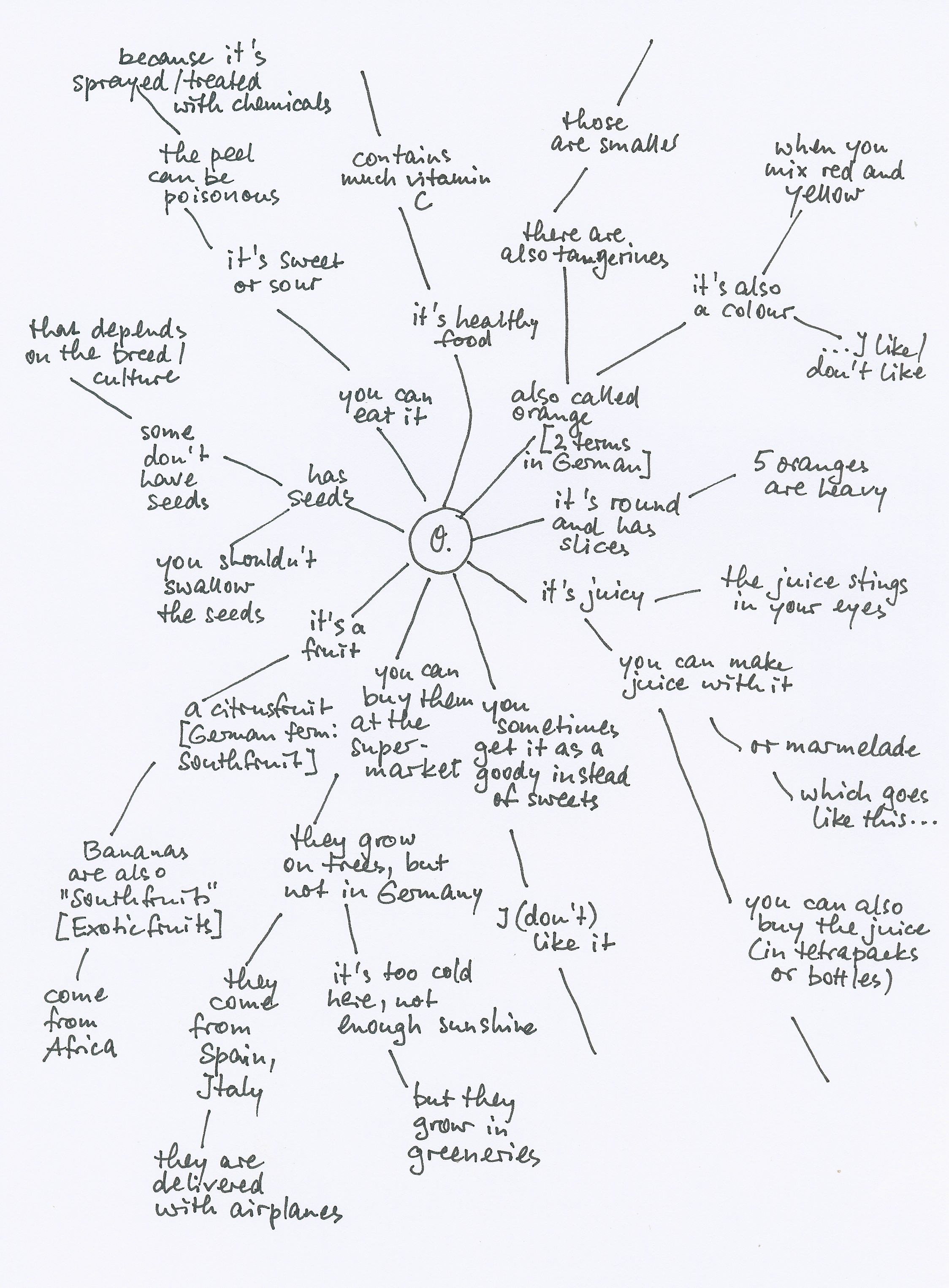
How does the brain process sensory impressions into terms?
This requires mental operations.
Example:
An infant sees:
The switch on the wall is pressed – the light goes on. At least, this is how older children and adults observe this event. The infant initially grasps it more like this:
Mummy touches a spot on the wall – something interesting happens.
So two pieces of information are picked up. At first, the child does not have to know what a switch is and that it has to be pressed. But if it experiences this happening frequently, the knowledge breaks through and the infant recognises the connection:
When the switch is touched, something interesting happens (this requires a mental operation).
It is very helpful if an adult recognises this process in the baby and supports its learning, for example like this: If mum then lets the child touch the spot itself and helps it to actually press if it is not successful, then it will also very quickly understand that touching alone was not enough here, but that you have to press here. What does this bring? From now on, the baby will not take over turning the lights on and off in the family, but it has been stimulated to think.
Later, the toddler hears the words „bright“, „lamp“ and „turn on“ and can link them to the ideas he has already acquired earlier.
Later still, the toddler is able to formulate this connection, which it has already recognised much earlier, into words in his head and – when he has also mastered the technique of speaking – also pronounce them.
(See also: Plans, Drawings, Sketches, Mind-Maps).
Important:
An example of an early thinking operation has now been described. There are other types and levels of thinking.
See also: How to Promote Thinking.
How does research work?
The bewilderingly complex world in which we humans find ourselves is gradually unravelled by each individual. The clever infant who observed the light being turned on has already begun to do this. It is working on building up its personal world view. The more diligently, precisely and intelligently it does this, the better its inner world view will correspond with the outer, with reality.
Mistakes happen to all of us – and now it depends on how flexible and efficient our brain is and to what extent we are prepared to recognise and overcome mistakes.
We all unravel the world more or less throughout our lives, which means that we are constantly learning something that is new to us. Every human being has to start this learning process all over again after birth. The knowledge needed to find one’s way in the world depends on the concrete environment in which the human being lives.
Even more decisive, however, is the epoch in which a person lives. It was neither possible nor necessary for an infant in the Middle Ages to come to terms with the phenomenon of a light switch. (Just as it is unnecessary for today’s man, unless he wants to become an antiquarian, to deal with the Latin language).
Where is the interface between learning and research?
Successful scientific research requires researchers to be very knowledgeable in their field (and perhaps in related fields). Acquiring this knowledge needs a lot of perseverance. Before they can successfully explore new things themselves, researchers have to spend a lot of their living time understanding the basics, many subtleties and the current state of research in their field – understanding it so well that they can operate with it mentally.
They also have to learn the special methods of their subject, they have to master the research equipment – and they have to work in a „field“, i.e. be involved in communication with their scientific colleagues.
Of course, our kindergarten children are still a long way from all this, even the gifted ones.
Nevertheless, children do research. And particularly gifted kindergarten children can achieve astonishing results.
One example is the four-year-old girl who discovered the principle of multiplication on her own. The example can be found in Giftedness – a Definition. Search there for: Lena (4;10) .
Young children (in contrast to scientific researchers)
do not normally explore anything
that is new to humanity, but they do explore
what is new to themselves.
And – apart from the preconditions described above – this research basically proceeds in exactly the same way as that of the „big“ researchers.
Research proceeds according to the following pattern:
-
- Observation and thinking lead to a question, according to the slogan: Here is something we don’t know yet – or also: Here is something that needs to be checked. In this way, the research question is explored and defined.
-
- Existing knowledge is collected and sorted. It can be our own observations, but mostly it is something that other scientists and practitioners have recognised and documented. So a lot of reading and enquiring has to be done.
- Conjectures are made about connections. This is the process of thesis formation. Initial ideas are drafted and tested for plausibility. A research hypothesis is formulated. (What result do we assume?)
- Then comes the planning phase: What knowledge is needed to move forward? Where can it be obtained? What things, resources and collaborations are needed?
- A research plan is drawn up: Consideration of a suitable experimental set-up, planning of experiments, assignment of subtasks.
- During and after the implementation come the documentation and the evaluation:
Could the hypothesis be confirmed – or does it at least seem more likely than before the research process – or must it be rejected?
- Now comes the repetition of the experiment to check the course and result(s) again.
- How can we communicate our results (in the scientific community / to the interested public)?
- What new, possibly more precise questions for further research have arisen?
A researcher can do all this alone in a quiet room, but it is usually more promising and therefore also common in modern research that there is a lively exchange with fellow researchers (though not necessarily with competitors) in all phases of the research.
And how do children do research?
At the beginning of children’s research there is also a question – although not always formulated or expressed.
Conjecture is followed by: Acquiring new knowledge through trial and error, asking others or reading if the child can already read.
By providing interesting material in the kindergarten or making exciting experiences possible (this can also be in the forest!), we encourage the children to intensify their research.
In the kindergarten, we can intentionally expand and specify these processes by inviting the children to experiment, for example. Here, gifted children often have more far-reaching needs than other children – and also already have other cognitive possibilities. Gifted children are often enthusiastic about the „comprehensive research process“, it is often not enough for them to simply look at what happens.
Looking at what happens is also important and valuable – it also does not need so much time and preparation by the kindergarten teacher.
But in the „comprehensive research process“ more preparation is needed. Here it is like with all activities in the kindergarten: the more experienced and skilled the teacher and the children are, the sooner individual children can be included in the preparation; the gifted children are ideal for this, but other interested children may also be enthusiastic about it.
Who doesn’t like to be an assistant to the kindergarten teacher?
Maybe there is a question at the beginning, but often the questions come up in the process.
When it comes to experiments, the kindergarten teacher should already have the experiment „down pat“. This means that she has already tried it out, possibly with a gifted or particularly interested child. Then the teacher does not have to pay so much attention to the course of the experiment, but can concentrate more on the children.
This is the typical procedure, which has many similarities with the research procedure of scientists outlined above:
-
- Obtain material.
- Try it out, carry out the experiment(s)
- Observe what happens.
- Evaluate, talk about what everyone has observed.
- Make assumptions / conclusions based on the observations.
- Is there a clear result? If there is no clear result: possibly improve/modify the experimental set-up.
- Repeat the experiment, observe, document.
- Re-evaluation: conclusions drawn from the observations.
- Repeat the experiment in any case! Does it work again? Do we see the same thing again? Does the same thing come out again?
A result is only valid if it can be reproduced!
-
- Accept or reject thesis(es)/assumptions.
- Better understanding of the phenomenon.
- Possibly develop new, further questions.
- Presentation of the results.
It helps us and the children if we keep this research sequence in mind.
Difference to scientific research: The kindergarten teachers (and perhaps individual children) usually already know what is likely to happen and also know the explanation for the observed phenomena.
However, there are also situations in which we cannot foresee the outcome of spontaneous experiments and certainly cannot explain it. That doesn’t matter if we can deal with it openly and show the children our efforts to perhaps still come up with a satisfactory explanation – or leave it at amazement for the time being.
The pedagogical art lies in really letting the children do their own research and only supporting them or challenging them with helpful questions where they (can’t) get anywhere on their own.
The children’s ability to work in a team develops as they work together. To this end, the children can already make important positive basic experiences in the kindergarten, on which they can build later.
For example, when experiments are announced in the kindergarten, some children already have good prior knowledge on which to build.
A kindergarten teacher, participant in an IHVO course, wrote in one of her assignments:
„We call ourselves „The Little Scientists Club“. The children all found this very exciting. I then asked the group who imagines what research is.
Kevin’s (6;3) answer was:
„Mmh, well you have to find out why things are the way they are; also you can do experiments.“
His answer showed me that he could immediately picture something under the term.“
Or to put it another way:
An experiment is a question to animate or inanimate nature.
A colleague I hold in high esteem, perhaps representing many kindergarten teachers, takes a somewhat different view than I do. She sees the goal at the end of the experiment not so much the correct resolution that corresponds to reality, but emphasises that even fantastic explanatory ideas should be allowed to stand.
She describes a situation where a five-year-old brings an experiment from home and demonstrates it for other children. At the end, four children express four different ideas, which are left as they are:
Jonas, 5.2 years: „Today you can experience something, because I brought a really good experiment.“ He takes a piece of cardboard out of his backpack with a painted arrow on it. He gets an empty glass and a glass filled with water from the kitchen.
Behind the empty glass, Jonas sets up his painted arrow and asks me to look closely through the glass. „I see an arrow pointing to the right.“
Jonas: „Yes, but here it comes, watch carefully.“
He now pushes the arrow further until it is behind the full glass. He doesn’t change direction.
Through the water-filled glass I can now see that the arrow is pointing to the left. Jonas repeats the process a few times and I am always fascinated. Some children who are watching us join in, stop for a moment, look through the water glass and move on.
However, three very advanced children linger, watching the process with me a few times. Jonas proudly performs his experiment repeatedly. I ask Levin if he might have an explanation for this amazing phenomenon.
Levin, 5;6 years: „I am just thinking if maybe there is a special chemical substance in the water. So something that acts like an optically confusing substance in our eyes, which then also manages to control something in our brain that makes us see the arrow from right to left all at once.“
Jonas, 5;2 years, the experimenter: „As soon as the arrow points in one direction as it does now – i.e. points to the right – and I then place a glass of water in front of it, the arrow is reflected on the surface of the water and seemingly, almost automatically, moves in the other direction.“
Lucie, 6;2 years: „My face is also reflected in a lake. When I look into it, I bend down very close to the water. But if I look into the lake from really high up, it looks as if I’m standing on my head.“
Alex, 5;6 years: „That’s only because it’s an optical illusion – and the water that’s between the glass simply changes the arrow in one direction or the other. It’s as simple as that.“
Now, one could leave these very clever ideas of the children as they are. But if I, as an kindergarten teacher, have an appropriate, scientifically sound explanation in mind, or can ask for it or read it out, then I would try to lead the children there. By asking appropriate questions, I would want to stimulate them, especially the particularly gifted children, to think further.
(See for example: A Hen´s Egg).
I believe that such a little Jonas, the experimenter, is intensely interested in an accurate solution. (And they are already close to it with the reflection on the surface of the water.) Here one could appreciate all ideas, even the one with the „chemical substance“ that „controls something in our brain“ is interesting. And then it would be nice to deepen the insights even more. We could also continue to work on the concept of optical illusion…
The fact that mankind still has a long way to go to find a plausible answer to all questions often enough makes us say that we don’t know or perhaps can’t know. These open questions leave a lot of space for the imagination of even the „strict thinker“.
And our individual naturally limited knowledge also narrows us down when we want to help children understand the world. However, I got to know a few kindergarten teachers who, in spite of their strenuous work, have familiarised themselves with new areas of knowledge out of their own interest, in order to see things more clearly themselves – stimulated by the children’s questions.
In my opinion, we should pass on what we know to the children. (Of course, we shouldn’t just tell them, but bring them closer to the solution by asking questions and letting them try it out).
I think the children have a right to benefit from our knowledge. It is also true that we can learn from the children in this situation. Often, for example, they observe much more precisely because they are not yet biased, or they bring in knowledge that is new to us.
For me, learning also means helping young children to distinguish as cleanly as possible: here fantastic ideas (which have their space in many areas, for example in fairy tales, stories or fantastic games) – and there objective reality, which is interesting for science – but also for the successful shaping of our own lives – and which we can approach better and better through more knowledge.
Here comes a small practical suggestion:
Ice eggs as a simple start for physics experiments.
Fill an uninflated balloon with water until it is about the size of a chicken egg. Knot it well and put it in the deep freeze overnight. The next day, remove the balloon cover, you now have a solid ice egg.
Make an ice egg this way for each child in your group and for yourself.
Safety note:
Check on your ice egg that the egg is not too cold. Otherwise, the children could hurt themselves when they hold the egg in their hands or lick it. If it should happen that a child sticks to the egg: have warm water ready, so that the fingers / tongue can be separated from the egg without pain and injury. You can also demonstrate this procedure on your own fingers. This shows the children that they have to be careful with ice, but not panic. (An Inuit uses his/her own warm urine in a pinch. But don’t panic, you should be able to find warm water in the kindergarten).
Go outside with the children and offer them the „peeled“, i.e. freed from the balloon cover, ice eggs. The air temperature should be well above 0 degrees Celsius.
My kindergarten children reacted very differently. Some took the egg immediately, others didn’t dare at first. Some immediately began to observe the egg and noticed that it was getting wetter and wetter and smaller and smaller.
As their hands got colder and colder, some children put their egg aside without comment and turned to other things, others generously gave it away. Some reacted immediately when I offered them compote bowls made of glass: they understood that this way they could protect their fingers from the cold, but continue to watch the ice melt.
Evaluation in the group circle:
How did the ice egg feel?
„It was freezing cold.“
„My fingers almost froze to death.“
What else did you notice?
„All of a sudden, the front of my jacket was all wet.“
„First it was big and then it was small.“
„It melted.“
„The ice became water.“
Was your jacket wet from the water? What can we do with your jacket to make it dry again quickly? ….
So the ice has become water. Is it also possible the other way round? Can water also become ice?
Some said yes – others couldn’t quite imagine it.
Who would like to turn water into ice?
Choose four to five children. If the other children are interested, they can join in later!
Now the children can experience how the ice eggs were created. They can try to fill the balloons themselves at the tap and tie them themselves. They can put the balloons into the freezer themselves.
What happened first? What happened to the ice egg? Some children were able to name the process clearly: It has melted – the ice has become water.
Here you should observe which children have further ideas and questions. You can then offer these children
more difficult experiments,
so that they do not remain frustrated.
You can find interesting examples in chapter 4.4.
And here is a brief overview of the
„Learning killers“.
Many things can hinder or prevent learning:
-
- The demands are too easy or too hard.
- The pace is too fast or too slow.
- There are too few or too many explanatory or practice repetitions.
- The learning person is asked to concentrate again and again on what he or she sees as unimportant; he or she sees no connection to his or her life.
- The learner does not see any connections between the educational morsels administered. The material is not structured in a meaningful way and is not derived from the previous ideas.
- The learner feels unfairness in the appreciation of his efforts and achievements (which are two different things, but both deserve recognition).
- The learner does not feel accepted as a person.
- The learner feels that what he thinks does not belong here or does not belong at all.
- The learning person associates fears with learning (fear of punishment, ridicule, failure). He is unrelaxed. See: It Takes Courage to Overcome Fears.
- There is an atmosphere of humourlessness.
Date of publication in German: December 2020
Copyright © Hanna Vock, see Imprint.

